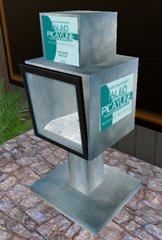Reasons to use Second Life in education
Learning Environment
As an alternative learning environment, it provides:
- an alternative and potentially neutral space away from the 'traditional' classroom, which can be socially inclusive for those learners which the formal establishment has woefully failed.
- enables real time interactions and global alliances which are not constrained by traditional 'location' based environments .
- In 20 years time, we will laugh at what we now call a VLE [Blackboard, WebCT, Moodle etc etc] as being very quaint and 2D!
Support Networks
- Formal and informal, multiple support networks - from peer to peer through to trusted intermediaries - through to synchronous and asynchronus communication channels
- Collaborative space. One of SL's huge benefits is the collaboration - both for learners and educational practitioners
Learning & Teaching Dynamic
- Enable all learners to experience a greater variety of teaching and learning styles - fab for kinesthetic and audio visual styles!
- Can help to blur the distinction between the role of the teacher and learner.
- Different opportunty for greater range of interactions with the teacher
- The traditional role of the teacher and the learner can become blurred, which potentially puts the learner more in control of their own learning [andragogic /heutagogic approaches]
- Allows different learning styles to be deployed and adopted - especially for kinesthetic and audio visual learning styles.
Assessment
- Alternative environment to support formative and summative assessment - from RARPA [recognising and recording progress and achievement in non accredited learning - http://www.aclearn.net/display.cfm?page=1290] through to virtual portfolios
- Fabulous opportunity to showcase work in an interactive 3D environment rather than a 2D website, or though paper portfolios
- Help learners to become more actively involved in designing and carrying out their own assessments.
Personalised Content
- Enables a 3D environment for curriculum areas from marketing and PR to fashion and design, languages to retail.
- Allows another technology solution to be deployed [working on the premise that the technology should support the learning and teaching and not the other way around!] It is also 'just another tool' that a teacher [or learner] can deploy as part of any learning episode.
Flexible Curriculum
- Enable the curriculum to be more bite sized and delivered anytime - anyplace - rather than the institutional and non flexible 9-5 Monday to Friday.
- Can link home/school – home / college
- Help to provide flexible learning pathways
- Enable learners to co-design, manage and access the curriculum in different ways
Downsides
Responsive Infrastructure
- Technical specifications for running SL are still very high for many users to effectively use SL to support learning and teaching. Therefore, there is a risk of supporting the 'digital divide' - those that have - and those that have not.
- E-safety - this is more about education that setting up yet more barriers [which I.T. departments revel in "How can we make it not happen"!] - but for organisations it is still a real issue from firewalls to learner safety.
- Connectivity - not all places have a decent broadband connection
Evidence and Evaluation
- I would very much doubt there is much robust [robust = key word] evidence yet that virtual worlds DO support learner retention, achievement or attainment. However, I also have no doubt that it is only a matter of time before that starts to filter through. The fact that the community is now over 6.2 million worldwide and at any one time over 20k are in-world suggests that something is good - and it isn't just sex!
Inspection Frameworks
- Certainly the UK, Educational inspectors through OfSTED just couldn't cope with Second Life - they can barely cope with the concept of email! Therefore, there will continue being a struggle using this technology as inspection is a major driver [along with funding]


No comments:
Post a Comment